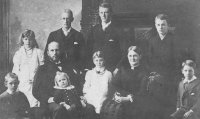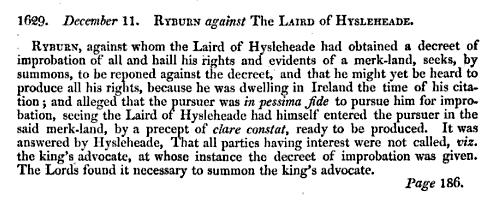 |
The History of the Ryburns -: IRELAND :- |
| Home | Variations | Ayrshire | Kintyre | Ireland | Americas | Au & NZ | Sources | Links | DNA |
 The first indication that Ryburns lived in Ireland was The first indication that Ryburns lived in Ireland was a 1629 court case, in which 'Ryburn' claimed he was living in Ireland when his Ayrshire property was taken from him by the Laird of 'Hysleheade' (Hessilhead). Exactly when this confiscation happened is not clear, but it may have occurred in, or shortly after, 1603, when a 'Johne Ryburne of that Ilk' was 'put to the Horne' for ignoring a summons 1629 court case in which 'Ryburn' claimed to have lived in Ireland accusing him of adultery and child murder. 'Put to the Horne' means to be pronounced an outlaw. "In Scotland the messenger-at-arms goes to the Cross of Edinburgh and gives three blasts with a horn before he heralds the judgment of outlawry." This 'Johne Ryburne' probably fled to Ireland to save his neck. For at least 60 years, the Ayrshire Ryburn's were caught up in a centuries-long feud between the Cunninghams, under the 'Earl of Glencairn', and the Montgomeries, headed by the 'Earl of Eglinton'. This feud dated from about 1448, when the King of Scotland was unwise enough to transfer the Baillieship of Cunningham to the Montgomeries. The Ryburns were tied to the Cunninghams by marriage. Two John Ryburns were involved in separate murders in 1570 and 1586. The former John was himself murdered in 1571. The 1586 incident was the infamous 'Murder at Annick Ford', where about thirty Cunninghams and adherents, including 'John Reyburne of that Ilk', attacked the Earl of Eglinton and a few of his servants. This was followed by a wave of bloody revenge, when Cunninghams, their friends and allies were pursued relentlessly by the Montgomeries and killed, or otherwise molested.  In 1603 the Laird of Hessilhead was Robert Montgomerie, and it was he who brought the charges against the unfortunate 'Johne Ryburne'. These accusations
were almost certainly false, as this sort In 1603 the Laird of Hessilhead was Robert Montgomerie, and it was he who brought the charges against the unfortunate 'Johne Ryburne'. These accusations
were almost certainly false, as this sortof dastardly revenge was common at the time. In the 1629 court case Montgomerie The 1603 proclamation outlawing 'Johne Ryburne of that Ilk' was claimed to have been 'in pessima fide', which is the opposite of 'in bona fide' -- he had forged the ownership papers ('precept of clare constat') for the property. 'Ryburn' must have succeeded in retrieving his 'merk-land' (about 200 acres), as this property, just northeast of Dunlop, was sold by Neil Ryburn to Gabriel Porterfield in 1638. Quite possibly, Ryburns joined the Hamilton-Montgomery Settlement, which commenced in County Down, Northern Ireland, in 1606. This had the approval of King James I of England (James VI of Scotland) and was the first and perhaps the most successful of several 'plantation schemes' in northern Ireland that eventually lead to the sectarian troubles there. On the other hand, the Ryburns may have been trying to steer clear of Hugh Montgomery at that time, and may have settled elsewhere in Ireland. James Hamilton was the eldest son of the first Protestant minister of Dunlop, Hans Hamilton, so the Ryburns would have known all about the settlement. However there is no record of the name Ryburn in the published County Down manuscripts of either Hamilton or Montgomerry. By this time Hamilton and Montgomery were bitter rivals. The appearance in 1673 of Patric Ryburn and Jane Baird in Garvachie Farm, Kintyre, strongly suggests a Ryburn born in Ireland. Other Kintyre Ryburns that are suspected of coming from Ireland include Edward Ryburn of Kilwhipnach Farm (married in Campbeltown in 1785), and Thomas Ryburn, the Campbeltown 'Scavenger'. The 1871 census says Thomas was born in Belfast, about 1828. In the 19th Century, the strongest evidence we have of Ryburns born in Ireland comes from the Scottish, English and US census data, and the arrival in New York of passengers from Ireland. In the 1841 Scottish census, an Edward Ryburn (or Pyburn), born in 1818 in Ringaskiddy, County Cork, was an able seaman on the ‘Black Prince’, a warship stationed at Greenock. In the 1881 British census, a Michael Ryburn, born in Cork, in about 1841, was a Royal Navy Coast Guard boatswain living with his family in Par Green, Tywardreath, Cornwall. His wife, Honor, was born in 1851 in Rostellan, and they had four children -- James b. 1873, Honor b. 1876, Helena b. 1878 and Mary Anne b. 1891. Rostellan is just across Cork Harbour from Ringaskiddy. In the 1870 US census in Portland, Connecticut, a literate John Ryburn, born in Ireland in about 1830, was described as a "common laborer on railroad". He was with many other Irish railroad workers. The 1900 census has a William Ryburn, born in Ireland in 1878, who emigrated in 1879, becoming a bar tender in Meriden, Connecticut. In Manhattan in 1910 was a servant, Nellie Ryburn (23), single, who was born in Ireland and emigrated in 1904. In 1920, in Essex, Massachusets, cabinet maker Joseph Ryburn (26), and his wife Carrie (27), were both born in Ireland. They immigrated in 1903. On 10 May, 1842, passengers Thomas (23) and Janet (19) Ryburn arrived in New York on the 'Scotland', from Cork in southern Ireland. On 12 Jun, 1849, Michael (50), Bridget (40), Mary (15), Daniel (9), Michael (4), and Catherine (4m) '?Ryburn' arrived on the 'William Larneston', ex Cork. Some of these names are not those you would expect of Scottish Ryburns. A John J. Ryburn (26) of Irish origin landed in New York in Sep. 1881 on the 'Wyoming', ex Queenstown (Cork). In July 1950, a Thomas Ryburn (54) of Ireland was a carpenter on shore leave from the ship Gardenia in New York. However, the possibiliry remains that some or all of these Ryburns were merely in transit via Cork, but ultimately from Scotland. Another possible connection to Ireland was a 50 foot sloop owned by a ‘P. Ryburn’, Scotland, that is in the 1810 Loyds of London Shipping Register. This boat was surveyed in Cork. The owner was either Patrick Ryburn (b. 1757), or Peter Ryburn (b. 1768), both of Campbeltown. Ancestry.com has recently made avalible an "All Ireland, Civil Registration of Births, Marriages and Deaths from 1864 to 1958". This purports to show ten Ryburn births, two marriages, and 7 deaths, mostly in the Schull (Skull) district of southwest Cork, but also in nearby Skibbereen and Goleen. However, comparison with the 1901 and 1911 Irish Census results reveals that at least some of these "Ryburns" were actually mis-transcriptions of the surname "Pyburn", which occurred quite frequently in this part of Cork. I cannot rule out the former presence of Ryburns, but the ballance of probability is that all were Pyburns. Two Ryburns are listed in the 1911 Irish census. However, I now think the Joan "Ryburn" (22), living with her married sister Mary Elizabeth Daly in house number two, Ringaskiddy, Cork, was actually a Joan "Pyburn". A family of Pyburns lived just next door, and in the image of the handwtritten census form her surname could well be "Pyburn". The 1901 Irish census also has a house of Pyburns, incuding a Joan Pyburn (13), right next door to a house of Dalys. That census has no Ryburns at all. I have seen with my own eyes the common grave these two families share in the Barnahelly graveyard, near Ringaskiddy. The Pyburn surname originated from northern England, but few of them are believed to have been granted land in Cork in the 16th century. There were about 60 Pyburns living in Cork in the 1911 census. In the Barnahelly graveyard, which is not far from Ringaskiddy, on the road to Carrigaline, is the gravestone of Ester Ryburn or Pyburn (d. 18 Dec 1972), and her sister Joan Scannell (d. 31 May 1976). Although the letters on the gravestone have been highlighted with black paint, the diagonal stroke of the first "R" in "Ryburn" exists purely in black paint and has not been inscribed with a chisel. The mason chiselled Pyburn, not Ryburn, so I rather think the former name is correct. Someone has confused the two names and tried to correct what they thought was an error. There is no record of an Ester Ryburn, or Pyburn, in either the 1901, or 1911, Irish census. This raises the possibility that all occurences of Ryburn in Ireland were a corruptions of the surname "Pyburn". Gravestone of Ester Ryburn or Pyburn, d. 1972, However, there are too many records of Irish Ryburns and her sister Joan Scannell, d, 1976. in the 19th and 20th centuries for this to be a consequence of multiple misreadings of the name Pyburn. There is not much doubt there were Ryburn descendants in Ireland whose ancestors ultimately came from Scotland (or possibly England). They may or may not have been descendants of the John Ryburn who fled to Ireland in 1603, and they could have been known to the Kintyre Ryburns. Other surnames, possibly related to Ryburn, that did occur in Ireland include Reyburn, Raeburn, Rayburn, Reburn, Reaburn and Raburn. Remembering that Raeburn had a separate origin to Ryburn, some of these variants, particularly 'Reyburn' and 'Reburn', could have been derivatives of Ryburn. According to Irish genealogy websites, the surname 'Reburn' originated from a place of the same name in Ayrshire, Scotland. This could well have been the Ryburn lands near Dunlop. However, the results of the four Ryburn DNA tests that have been done to date suggest there is no close genetic relationships with many of these spelling variants. Most of these names had precedents in Scotland. More DNA tests may clarify this. Last updated 9 July, 2015 |